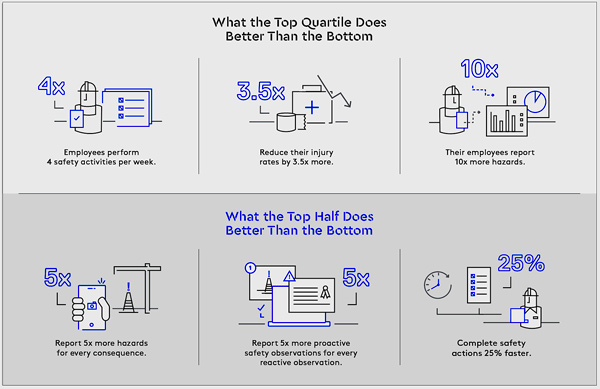Reducing workplace injuries is intentional.
Laws, regulations, training programs and improvements in PPE (personal protective equipment) have made the workplace less dangerous since the 1940s.
However, improvements have stalled since the 1990s. Building a strong safety culture is seeing risk where none was seen before and actively mitigating risks before they become fatal.
Ninety-eight per cent of safety professionals believe participation improves safety performance. We (eCompliance) define safety performance as the reduction in workplace injuries and incidents over time. Participation is often defined as all the safety activities performed by a company. Sophisticated companies have successfully been able to narrow down this definition and identify specific indicators they focus on to improve safety performance.
What are the safest companies doing?
We randomly selected 40 companies in varying industries including construction which represented 28 per cent of our respondents to better understand their safety behaviours.
We discovered that organizations with a high participation safety culture (our top quartile) had the following outcomes:
- The top quartile reduced injuries by 71 per cent, while companies in the bottom quartile reduced injuries by 20 per cent.
- The top quartile reduced incidents by 84 per cent, while companies in the bottom quartile reduced incidents by 40 per cent.
Our research also showed the highest performers we studied have their front-line employees performing an average of four safety activities (i.e. an equipment inspection or vehicle check) a week. So, that’s nearly one safety activity per day. To further understand what the “top quartile” or “safest companies” had in common, we decided to conduct one-on-one interviews and better understand their journey to get there. From these discussions, we were able to uncover the following five steps that each organization took
- CEO commitment: The CEO makes a sincere and public commitment to safety. Beyond their mission/vision statement, the CEO was practicing and actively demonstrating their commitment to safety throughout the organization.
- The rise of the safety leader: The CEO appoints and publicly backs someone to drive new safety efforts/manage them throughout the company.
- Employee buy-in: The safety leader gets front-line employees on board and engaged in participating in safety. With strong leadership skills, they’re able to change the way everyone thinks about safety.
- Safety reflux: Management reacts to their front-line carrying out more safety activities by responding to them in a timely fashion. Most companies get stuck here.
- Safety velocity: The company has reached a high participation safety culture and actively works to maintain their standards and reputation.

Why do companies get stuck at Step 4?
Often times, organizations will state “safety is now their number one priority.” Then, they hire a great safety leader who implements a new system and manages the team and makes some impactful change to help improve safety performance and reporting. Then, something happens.
A piece of equipment is reported broken, or someone injures themselves on the job or something happens that requires “action.” Unfortunately, this is where companies fall short. This is where the communication line breaks.
The second that something remains unattended to, the slogan of “Safety is #1” and the great safety leader you have in place lose employee buy-in. They start to lose trust in this being a process that has top-down commitment. So, you must be wondering, how do I avoid this?
The likely scenario is that the delay wasn’t caused by purpose. The company truly does care, but the picture being painted to the front-line seems to be the opposite. In most scenarios, this is because our fearless safety leaders aren’t given the right tools, time and training to be able to instantly react to all the safety activities.
Unfortunately, it’s common to get caught up in the quick implementation and execution of a new safety program without taking the time to ensure it’s set up appropriately. More importantly, the people behind it are set up with the tools they need for success.
In order to overcome step four, companies should make a conscious effort to build an implementation plan for their team. This isn’t something that can happen overnight; however, if done correctly, it’s a program that will receive employee buy-in and be sustainable.
A high participation safety culture leads to fewer workplace injuries and incidents and improved financial performance. Companies in the top quartile of participation have significantly better safety performance compared to their peers. However, completing all five steps is of utmost importance if you want to maintain your high participation safety culture.
Adrian Bartha is the CEO of eCompliance. Send comments and Industry Perspectives column ideas to editor@dailycommercialnews.com.











Recent Comments